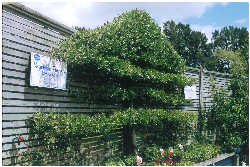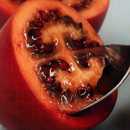Olives |
Olea europaea |
|
||
|
||
|
||
 |
||
 |
||
 |
||
The Olive is a species of small tree in the family Oleaceae, native to coastal areas of the eastern Mediterranean region, from Lebanon and the maritime parts of Asia Minor and northern Iran at the south end of the Caspian Sea. Its use as a major agricultural product in preclassical Greece led to its wider distribution throughout the western Mediterranean. The olive is one of the earliest plants cited in recorded literature.
Landscape Value
Use a row of Olives as a hedge or as a stand alone tree in the corner of your garden. They also look good in a container so place on a patio or deck to create a Mediterranean feel.
Nutritional Value
Well know for its oil which is rich in oleic acid and good for cardiovascular health. Monounsaturated fat which is 'good' cholesterol and may help with inflammation in joints etc.
How to Eat
The fruit of this plant is initially inedible, and must be treated before it can be eaten. It may be processed either while unripe, to produce "green olives", as with the martini olives stuffed with pimento, or when ripe, to produce "black olives", as are used on pizza, some Mexican food, and Mediterranean-style salads.
Expected Yield
40 kg
Generic Fruiting Time
| J | F | M | A | M | J | J | A | S | O | N | D |
Growing
Sun
Full sun
Wind
Shelter is important so that trees can establish well and do not damage as they mature, they have a shallow root system. Some air movement is needed for pollination as well as to dissipate frost pockets during winter.
Climate
Every area of the country is often considered to have it's own general set of growing conditions but within these areas there are localized microclimates. Even within the average garden there are microclimates that will suit some plants better than others. When choosing a spot for Olives, the basic requirement is warm dry summers and cool winters, that are not too wet. If high rainfall is to be expected, then good drainage becomes more important. Most of the country experiences enough chill to satisfy Olives, but late frosts at flowering time can be a problem. It is difficult to accurately make recommendations for any areas without some local experience. Fruit size is determined by a combination of variety selection, soil type, nutrition, timing of water availability, tree training and crop load. The main aspect to keep in mind in the garden is water availability since there is often root competition in the garden, even if it is only the lawn. Spring to mid summer water stress will limit the size of fruit. Dry conditions later in the summer will assist maturing of the fruit. Larger fruit are preferred for pickling so supplementary water in summer (similar to the requirements of citrus trees) combined with some fruit thinning will be an advantage.
Soil
Olives generally prefer a free draining soil with reasonable moisture retention, but some cultivars are more tolerant of heavy soils. Local rainfall patterns tend to simplify or compound problems associated with difficult soil conditions. Overseas heavier soils are usually associated with Mediterranean climates which suit the Olive better. This will result in the moisture patterns required for optimum production. These heavy soils also tend to hold trace elements better than many of New Zealand's lighter soils, so trace element requirements need to be considered on a site by site basis in New Zealand.
Fertiliser
Olives require the full range of soil nutrients but not too much nitrogen. Careful selection of seaweed fertilizers will address the trace element requirements as well as the general nutrient needs.
Pruning
Trimming for a more open canopy will assist pollination, air movement, spray penetration and fruit colour.
Pests
A winter spray program combining at least one oil/copper spray in winter as for citrus is advisable. Also a copper spray in spring before flowering commences should be adequate to control any fungus problems. Leaf roller caterpillar can be a problem so watch for this throughout summer, especially on young plants.
Hardiness
-12°C
Special Conditions


